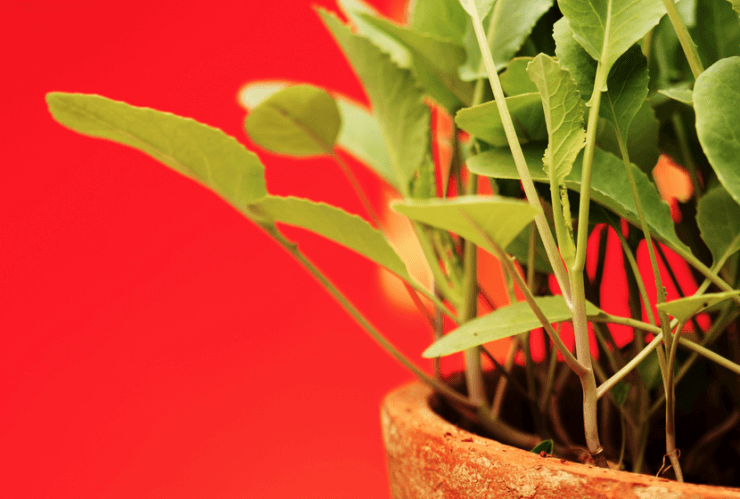
Cauliflower seedlings in container
Because cauliflower has shallow roots, it’s ideal to grow in a container. The main thing to remember will be watering, as soil dries out much faster in a pot than it does in the garden. Use a container mix from the garden store, as it’s fluffier than regular garden soil and holds moisture better. Purchased soil also means you won’t have to worry about surprise pathogens in the soil!
The benefit of growing cauliflower in a container is that it’s easier to control the elements that make the plant such a challenge. Plus, a cauliflower in a pot is much easier to access, which make tending to it that much easier. You also don’t have to rotate crops like you would in a garden.
Choosing a container
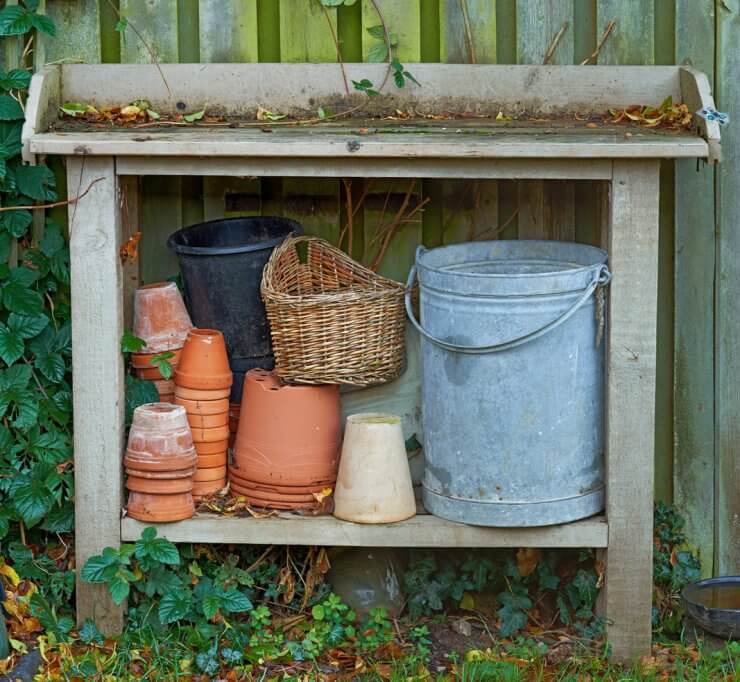
Pots and containers for growing vegetables
You won’t need a really deep container, just one that’s wide enough to accommodate a mature cauliflower plant and provide it with enough soil to draw moisture and nutrition from. So pick a pot with a minimum depth of 8 inches and a width of 18 inches for one plant. If you want to grow more than one, pick a container that allows for 18 to 24 inches between plants, or buy multiple pots.
Terra cotta pots are usable, but they dry out pretty fast so you’ll have to be vigilant with the water level. Cement or stone pots tend to retain water better but they’re heavy, so consider putting them on wheeled platforms so you can move them around without strain.
Plastic or metal containers work best because they retain water well, but they’re light enough to move easily. And you will probably want to move your cauliflower to protect it from the afternoon heat.
Whatever type of pot you’re using, make sure it has at least one 1/2-inch drainage hole for every square foot of surface area at the base of the container.
If you think you’ll have trouble keeping up with watering your cauliflower— and remember, it’s highly sensitive to interruptions to its water needs— consider a container with a self-watering system.
Finally, if you’re using an old container, it’s always a good idea to sanitize by wiping it down with a mixture of 1:10 bleach to water. That way, hidden pathogens from the last plant that occupied the container won’t surprise your cauliflower.
Planting your cauliflower
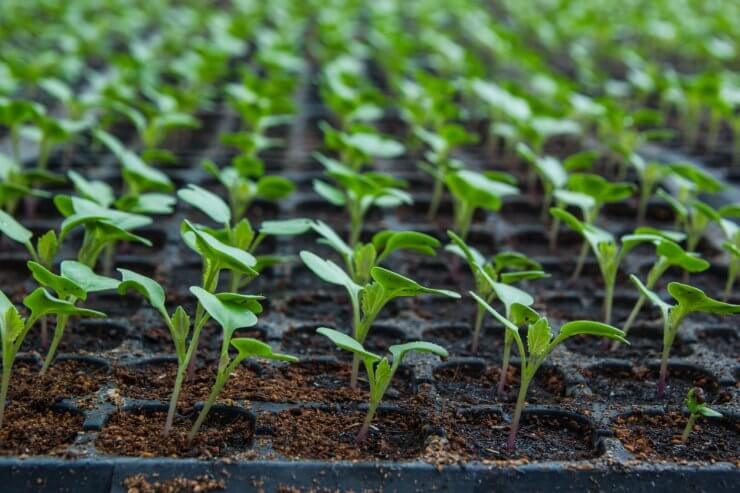
Cauliflower seedlings in containers
Plant seeds either directly in the container, or indoors in peat pots. The goal in deciding when to put seeds or plants outdoors in the pot is to make sure the plant can reach maturity before the summer heat or winter frost hits, depending on your climate and growing season.
When planting directly in the container, sow seeds 1/2 inch deep. Space the seeds about 2 to 3 inches apart. Water the soil thoroughly, but be careful not to disturb the seeds. Keep the soil moist, but not waterlogged. Seeds should germinate in about 10 to 14 days.
Ensure that the seedlings get at least eight hours of sunlight per day as they mature.
Thin to 18 to 24 inches apart (if you’re growing more than one in a pot), or remove all but the strongest seedling from each pot when they develop two true leaves.
If you’ve started your seeds in peat pots indoors, or you’re transplanting purchased seedlings, dig a hole in the potting soil at the same depth and twice as wide as the seed starter pot or nursery start. Remove the seedling gently, taking care not to damage the roots, place it into the hole and backfill with potting soil.
You can apply an all-purpose fertilizer, following the instructions on the package. Be careful in choosing a fertilizer, because one that’s too strong will burn the tender roots.
If you started your seeds outdoors in the pot, seedlings should be fertilized for the first time when they’ve developed at least two sets of true leaves.
Caring for your potted cauliflower
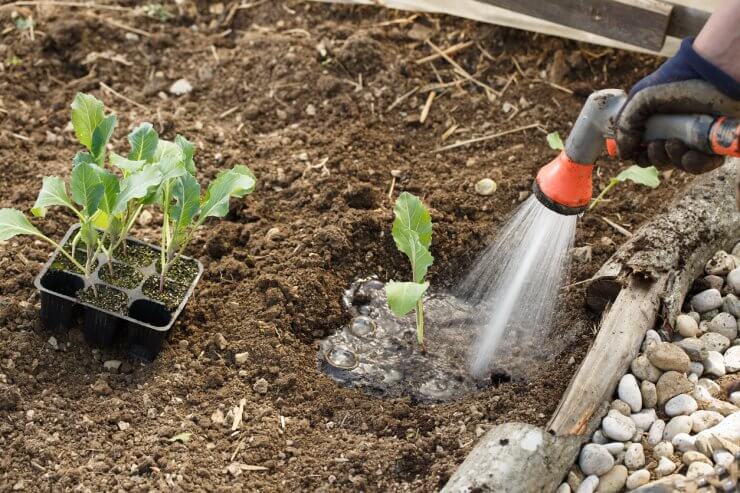
Cauliflower needs proper watering
Remember, cauliflower absolutely must have consistent water. Without it, the heads won’t form properly. And because pots dry out so much faster than soil in the garden, consider investing in a drip irrigation system.
When you first pot a plant in its container, fill it up and water it until the water runs out of the drainage holes. Check the plant in 12 hours or so and stick your finger a few inches deep in the soil to determine if it feels dry or wet.
If the soil is wet and your finger comes out muddy, it’s retaining water well and you can give your plant less water next time. If it’s dry, give your cauliflower a longer soak in future, or water more often. This way, you’ll have a good benchmark for how long your pot holds water.
Of course, you’ll have to adjust your watering schedule as the weather warms up or when it rains, but this is a good starting point. Soil should consistently feel moist, like a well wrung-out sponge, as far as you can stick your finger in. If it feels dry, give it a good soaking, or if it’s too wet, let it dry out a bit. You can also put down a 1-inch layer of mulch to help retain water.
Even though cauliflower needs full sun, be prepared to move your pots if the days heat up to 75 degrees F or higher. Get that cauliflower into the shade if that happens, spring or fall.
Re-apply your fertilizer every two weeks, following instructions on the packaging.
If you’re growing a white cauliflower that’s not a self-blanching type, you’ll need to shield the cauliflower head from excess sunlight. Blanching is the process of securing the leaves above the head to protect the head’s creamy white color and prevent it from turning bitter.
Another benefit of blanching is that blanched cauliflowers will better withstand a light frost. Just remember that continued winter weather will cause the plant to bolt, or turn the head mushy.
Deal with pests and diseases as you would if your cauliflower were outside in the garden.
Bolting
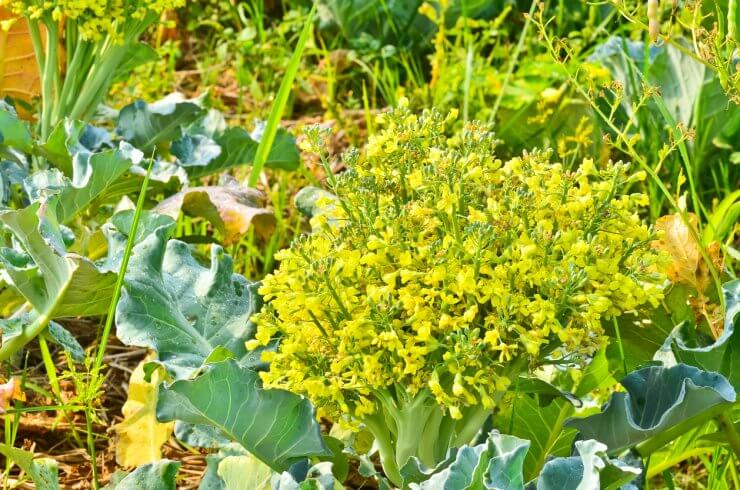
A bolted cauliflower plant
One of the disadvantages of growing cauliflower in a pot is that it can be more prone to bolting. Bolting is when the plant shifts into survival mode by producing flower stalks and seeds—but no cauliflower head.
Bolting is usually caused by too much heat or cold, or too little water. Containers heat up faster than ground soil, especially if they’re placed on cement, tarmac, or dark wood. Be vigilant about checking the pot’s temperature with your hand, and if it’s getting hot, move the pot into the shade.
Consider investing in a soil thermometer to keep an even closer eye on the temperature.
Have you successfully grown cauliflower in a pot? Please share your experiences with us.


 Previous
Previous

